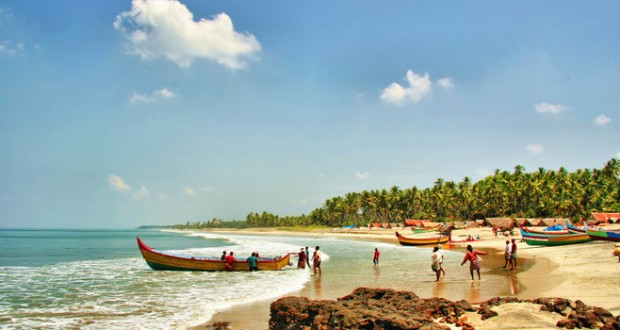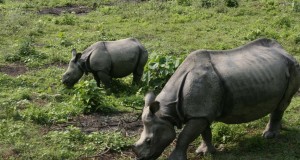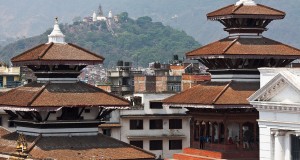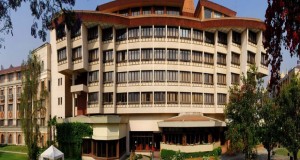Padmanabhaswamy Temple–Secretariat–Zoo and Botanical Gardens–Napier Museum–Art Gallery
The city’s most interesting sight, Padmanabhaswamy Temple, is unfortunately off-limits to non-Hindus. This said, some travellers have gained access. They have sought and gained permission from the Ramakrishna Centre, near the temple. You must wear traditional
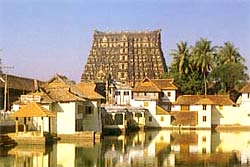 dress inside; men wear dhotis and women saris. The temple itself is a fine example of south Indian architecture, constructed in the Dravidian style by a Maharajah of Travancore in 1733 and dedicated to Lord Vishnu, the presiding deity of Trivandrum. It is the landmark of the city, notable for its magnificent seven-storeyed gopuram, reflected in the placid temple pool, and for its intricate carvings and murals. Even if you can’t get in, the exterior view is fine, and there are many interesting old houses in the surrounding backstreet . At 4 pm Vishnu is taken on his daily procession round the temple grounds.Proceeding north up M.G. Rd by rickshaw, look out for the Secretariat on your right.
dress inside; men wear dhotis and women saris. The temple itself is a fine example of south Indian architecture, constructed in the Dravidian style by a Maharajah of Travancore in 1733 and dedicated to Lord Vishnu, the presiding deity of Trivandrum. It is the landmark of the city, notable for its magnificent seven-storeyed gopuram, reflected in the placid temple pool, and for its intricate carvings and murals. Even if you can’t get in, the exterior view is fine, and there are many interesting old houses in the surrounding backstreet . At 4 pm Vishnu is taken on his daily procession round the temple grounds.Proceeding north up M.G. Rd by rickshaw, look out for the Secretariat on your right.
It’s an impressive building, fully reflecting the pomp and circumstance of the British Raj. No less impressive is the large museum complex to the north of town. Here are the spacious Botanical Gardens, 80 acres of beautifully laid-out lawns, lakes and woodlands. Practically every known variety of tropical tree can be found here. Within the grounds is the dingy and rather depressing Zoo, the magnificent Napier Museum housing a famous collection of bronzes and Sri Chitra Art Gallery with a modest display of Indian and far-Eastern paintings. The complex is a good place to bring a packed lunch, and spend a relaxing day. It’s open 10 am to 5 pm daily, except Mondays. Entrance is Rsl, plus a further Rs2 to visit the art gallery.
Excursions
Ponmudi
This minor hill station, 60 km (56 1/4miles) from Trivandrum, is a useful 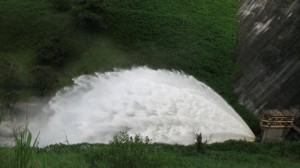 escape from the heat and noise of the city. It’s located 1000 m up in the lightly-wooded southern end of the Cardamom Hills, with a cool climate and excellent views. The forest trails are good for hiking and bird-watching, and the scenery is uniformly beautiful. Avoid weekends, when it gets busy with local tourists who turn up with blaring cassette players. Contact the tourist office in Trivandrum at least a week ahead if you want to stay overnight. Most people treat Ponmudi as a quick away-day excursion. The short bus-trip up there (2 hours) passes through good forest, and then tea plantations, making a stop at a pleasant waterfall. Accommodation is either at Government Bungalows (double rooms for Rs60) or Ponmudi Tourist Resort (tel Vithura 30), with cottages and rooms from Rs75.
escape from the heat and noise of the city. It’s located 1000 m up in the lightly-wooded southern end of the Cardamom Hills, with a cool climate and excellent views. The forest trails are good for hiking and bird-watching, and the scenery is uniformly beautiful. Avoid weekends, when it gets busy with local tourists who turn up with blaring cassette players. Contact the tourist office in Trivandrum at least a week ahead if you want to stay overnight. Most people treat Ponmudi as a quick away-day excursion. The short bus-trip up there (2 hours) passes through good forest, and then tea plantations, making a stop at a pleasant waterfall. Accommodation is either at Government Bungalows (double rooms for Rs60) or Ponmudi Tourist Resort (tel Vithura 30), with cottages and rooms from Rs75.
Varkala
Exactly 1 hour by train from Trivandrum (55 km; 35 miles), this delightful little seaside resort has a mineral-water spring, a Vishnu temple dedicated to Lord Janardhana with fascinating rituals, a beach that is empty except at weekends, with good swimming, and lovely country scenery. Cheap places to stay include the Tourist Bungalow a 5-minute walk up hill from the bus-stand; clean Rs75 doubles, G.A. Lodge (near bus-stand), and Donkey Lodge (on the way to the beach). There are several long-stay travellers at Varkala, mainly in the area of the Krishna temple. A famous saint called Sri Narayana used to live here and many followers have stayed on.
RECREATION
Two troupes, Kathakali Club and Drisyavedi, give displays of traditional 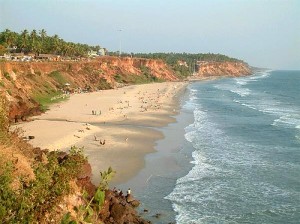 Kathakali ‘story-play’ dance twice monthly, usually at the Karthikathirunal Theatre, near to Padmanabhaswamy temple. Both outfits draw their players from the Margi School of Kathakali, near the West Fort, and if you turn up at the Fort High School behind Padmanabhaswamy temple in the early morning, you can make an appointment to ‘sit in’ on classes the following day.
Kathakali ‘story-play’ dance twice monthly, usually at the Karthikathirunal Theatre, near to Padmanabhaswamy temple. Both outfits draw their players from the Margi School of Kathakali, near the West Fort, and if you turn up at the Fort High School behind Padmanabhaswamy temple in the early morning, you can make an appointment to ‘sit in’ on classes the following day.
Kalarippayat, the martial art of Kerala, is best seen in the C.V.N. Kalarisangam, East Fort (just below Padmanabhaswamy temple), where maestro C.V. Govindkutty Nair normally holds classes between 6.30 and 8 am. Kalarippayat is being increasingly recognised as the parental martial art of Asia; the forerunner of Thai kickboxing, karate, kendo, judo, and kung fu, using 14 weapons and the whole range of unarmed combat methods. It also teaches an advanced system of massage therapy. For more information, contact G.P. George, himself a Master of Kalarippayat, at Taurus Lodge, Statue Rd.
Instruction in yoga and ayurvedic massage is given by Dr Pillai at the Yoga Therapy Hospital in Bazhuthacaud Junction. The doctor prefers you to take the full 3-month course, but if you’ve only a week to spare, he may decide he can do something for you.
From the sublime to the mundane, the Veli Tourist Village has just opened up 9 km (5 3/4 miles) out of Trivandrum. This has landscaped gardens, sculptures, wading pools, water-sports, motor boats, even a hovercraft; the full range of Indian-style ‘fun’ recreations. Earplugs are a must on busy weekends. Accommodation here is at the village (Tel 71364) or Hotel Lakeside Tourist Home with rooms from Rs85.
SHOPPING
Popular buys in Trivandrum are carvings and curios, bell-metal lamps, screw-pine items, handloom fabrics, and Kathakali masks and dolls in papier mache or wood. The two (good) government emporia are Kairali (tel 60127) at Statue Junction, and SMSM Institute, behind the Secretariat. Both are fixed-price establishments, offering the full range of local produce. Although some shops still offer ivory items the sale and export of ivory is banned by both Indian and international law.

